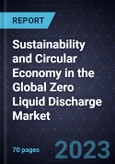Water Security Concerns, Stringent Legislation, and Attractive Resource Recovery Revenue Streams Drive Market Growth
The water crisis necessitates technology developments that safeguard water availability and quality, supporting sustainable industrial practices and avoiding pollution of land and water bodies.
The Zero Liquid Discharge (ZLD) market advances novel technologies that tackle the challenges of cost and energy consumption focused on improving membrane-based systems that can replace thermal-powered products with heightened environmental impact and CAPEX and OPEX. Innovative pretreatments and membrane processes, including FO, EDR, and MD, are expected to displace thermal brine concentrators over the 2024 to 2030 forecast period, while developments in evaporation and crystallization technologies are set to improve these products' economic and environmental viability.
Stringent water protection and effluent limitation regulations, water scarcity, growing public awareness and concern over environmental issues, socioeconomic trends such as urbanization and industrialization, as well as material recovery opportunities will likely drive the demand for ZLD solutions. The publisher estimates the global ZLD market at $851.5 million in 2023. The market is expected to grow at a 14.1% CAGR, reaching $2,146.6 million by 2030.
Research Scope
The report analyzes the global ZLD industry trends and factors impacting market growth and technology development. Other important information includes:
- Mapping key competitors across technology segments, identifying companies to action that are expected to drive value in the market, with an in-depth analysis of the degree of concentration and revenue share distribution.
- Distribution channels and pricing trends that influence ZLD systems, providing a general understanding of the solutions providers and suppliers in the market.
- Regional analysis of the Americas, Europe, Asia-Pacific, and the Middle East and Africa.
- Potential market growth opportunities that are underdeveloped and set to experience high growth and engagement rates in the forecast period.








